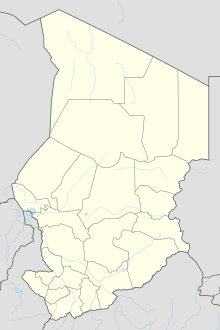Bardaï
Coordinates: 21 ° 21 ′ 16 ″ N , 17 ° 0 ′ 2 ″ E
Bardaï (so the Arabic name, also برداي, in the language of the locals, Tedaga , the place is called Goumodi ["red passport"]; in German literature the place is usually simply written Bardai ) is a small town with 1500 inhabitants in the northwest of Chad and capital of the Tibesti region, created in 2008 .
The infrastructure of the place
In Bardai there is a school, a small mosque, a garrison of the Chadian army, since around 2010 a hospital (the only one in the entire region) and several shops. As in most of the larger Tibesti oases, Bardai has small, garden-like fields where grain and vegetables are grown, as well as a date palm grove. Bardaï can be reached via the Bardaï-Zougra airfield .
Bardai in the administration of Chad
The Tibesti region consists of two departments, Tibesti Est and Tibesti Ouest (East and West Tibesti), with Bardaï belonging to the eastern department and being its main town. The Tibesti Est department, in turn, is divided into the four sub-prefectures of Aouzou , Bardaï, Yebbi-Bou and Zoumri . Bardai is also the capital of the Tibest region, the department of Tibesti Est and the sub-prefecture (sous-préfecture) Bardai. Sub-prefect of Bardai in 2008 was Sougoumi Chahaimi.
history
The first European to report in detail about Bardaï was the German African explorer Gustav Nachtigal . He reached Bardaï in 1869 coming from Mursuk , but had to flee after a short time because of the hostile attitude of the local Tubu people. In the summer of 1914 France conquered the Tibesti and set up small garrisons in Bardai and Zouar , which had to withdraw again in 1916.
In 1965 Jürgen Hövermann and Horst Hagedorn opened a research station in Bardaï.
In 1974, Bardaï gained international attention when a rebel group led by Hissène Habré attacked the city and captured the French archaeologist Françoise Claustre , the French aid worker Marc Combe and the German doctor Christoph Staewen as hostages. Several people were killed in the action, including a. also Staewen's wife Elfriede.
In the so-called Toyota War between Libya and Chad 1986/87, Bardaï was fought over several times.
literature
- Christoph Staewen: Eine Fahrt ins Tibesti , Verlag G. Richter, 1st edition 2005, ISBN 3-00-015063-3 (travel report from spring 1964)
Individual evidence
- ↑ http://www.airport-data.com/world-airports/FTTZ/
- ↑ Reinhart Mazur: Pioneer trip to Tibesti - To the 'White Spot' on the Sahara map; 1992-2008
- ^ Horst Hagedorn: The research station Bardai / Tibesti - a review . In: The Earth . tape 135 , no. 3-4 , 2004, pp. 237-243 ( PDF ). PDF ( Memento of the original from December 22, 2015 in the Internet Archive ) Info: The archive link has been inserted automatically and has not yet been checked. Please check the original and archive link according to the instructions and then remove this notice.
- ↑ http://archiv.preussische-allgemeine.de/1974/1974_07_06_27.pdf
- ^ German rebel radio . In: Der Spiegel . No. 25 , 1974, p. 16-17 ( Online - June 17, 1974 ).
- ↑ Make you cry. A French archaeologist is threatened with shooting in Africa because Paris was reluctant to pay the ransom for reasons of state . In: Der Spiegel . No. 38 , 1975, p. 96-98 ( online - 15 September 1975 ).
